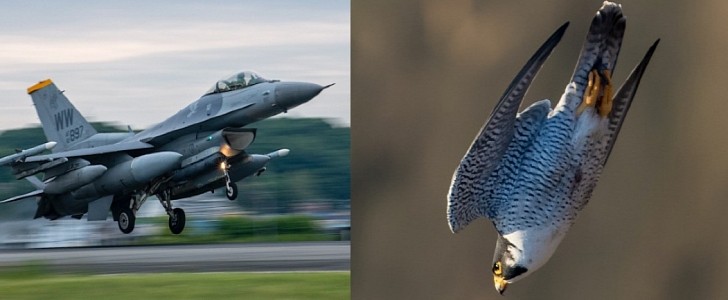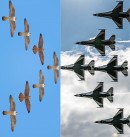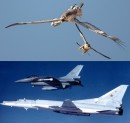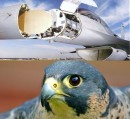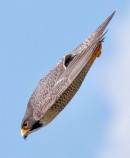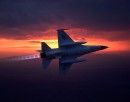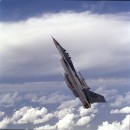We're fans of just about anything that goes crazy fast here at autoevolution, even if on the sneak, sometimes they have wings, a beak, and squawk. But the description of the world's fastest bird, or rather, the world's fastest animal, the Peregrine Falcon, fascinates us the most.
Avid birdwatchers call the Perigrine Falcon the fighter jet of the animal kingdom. That seemingly arbitrary comparison has our noggins jogging. How exactly is a Peregrine Falcon like a fighter jet? Let's compare some of its flight characteristics to a real one, the General Dynamics F-16 Fighting Falcon, to find out. We bet you've never seen a comparison quite like this.
As it happens, both Falcons are built from the ground up by either evolution or engineers for speed, agility, and to be brutally deadly in combat. In the case of the F-16, the whole point of the airplane's existence was to be considerably lighter than preceding fighters.
The F-16 was built with a wide degree of aviation-grade aluminum alloy, lightweight composite metals, and a sprinkling of super strong titanium throughout to create an airframe considerably lighter and smaller than any operational American fighter jet. In the same way, Peregrine Falcon flight feathers are some of the lightest and strongest in the animal kingdom.
Their relatively condensed, angular, and surprisingly lightweight wings almost mimic the cropped delta wing of the F-16. Both sets of wings cut through the air with an absolute minimum of air resistance. In many ways, it's a more biological means of attaining the same flight characteristics.
In the end, the results are remarkably similar. The Peregrine Falcon can easily crack 200 miles per hour in flight (322 kph) with a relatively low angle of attack. It can stretch that speed up to 390 kph (242.3 mph) in one of its trademark screaming power-dives, or "the Stoop," as avian observers call it. As it happens, the silhouette of a Peregrine Falcon in a stoop is strikingly similar to a Northrop Grumman B-2 Spirit Stealth Bomber.
Scale the abilities of a Peregrine Falcon to the size of an F-16, and suddenly the comparison becomes even more intriguing. The F-16C Block 50 Fighting Falcon, equipped with a General Electric F110-GE-129 turbojet engine, maxes out at just over twice the speed of sound (1,353 mph; 2,178 km/h).
A little simple math shows the F-16 is almost exactly 5.5 times faster than its bird cousin. From that point of view, the biggest difference between the fighter jet of the animal kingdom and a legitimate fighter jet is a matter of degree. From that perspective, the comparison between this utterly remarkable bird and one of the world's most prolific jet fighters isn't so ham-fisted.
Taking it a step further, a Peregrine Falcon can pull as much as 25 times the force of gravity (25Gs) when intercepting low-flying prey in a dive and rapidly pulling up into a climb once the attack is carried out. That kind of G load would rip the wings off an F-16. Or really, it'd rip the wings off of pretty much anything man-made subjected to those forces. It's the benefits of being small and made of feathers and hollow bones in a nutshell.
But even so, it's still the most nimble and maneuverable fighter in the USAF's arsenal, owing to its relatively small size and weight. A maximum G-force endurance rated for the F-16 airframe of nine Gs still shows the remarkable scaleability between these two flyers. In another classic instance of biomimicry, you'll notice the Peregrine Falcon has small protrusions of bone sticking out of its nostrils.
These protrusions, called tubercles, direct a torrent of air to be simultaneously slowed down and redirected into its lungs in super high-speed flight. This is a principle used in the air intakes for turbojet engines. In the case of the F-16 especially, the structural support strut for its undercarriage-mounted air intake looks remarkably similar.
This supportive brace likely doesn't serve quite the same function as the tubercles of a bird in the case of the F-16. That said, plenty of fighter jets did use splitter plate intakes for this very purpose and are using the exact same physical forces. Often to direct torrents of air into one of two jet engines, as is the case with the Mikoyan Gurevich MiG-19 and the Eurofighter Typhoon, among others.
In terms of avionics and navigation equipment, The Peregrine and Fighting Falcons have some of the best in the world. Most flying birds have decent eyesight, but the Peregrine Falcon's is genuinely next level. Most mammals have a point in the back of their eyeballs where their vision is the clearest and the light the most defined, called the central fovea.
The Peregrine Falcon, however, has one extra such point called the temporal fovea. It's as close to an internal scanning Radar system as you're likely to find in the animal kingdom, and it allows the Peregrine Falcon to scan for aerial and ground prey with weapon-like precision. It can use everything from the point of its beak, its razor-sharp talons, and even the kinetic energy of its body in flight to immobilize a wide variety of prey.
Meanwhile, an F-16E/F model's AN/APG-80 active electronically scanned array (AESA) radar system performs ostensibly the same function. Being able to scan for threats in the air, on the ground, and aid in guiding air-to-air and air-to-ground smart munitions like AIM-120 AMRAAM air-to-air missiles and AGM 65 Maverick air-to-ground missiles, among a slew of others. When you put everything together, it really does seem like the comparison between a fighter jet and a Peregrine Falcon isn't flat hyperbole. There's some real, genuine science behind it.
As it happens, both Falcons are built from the ground up by either evolution or engineers for speed, agility, and to be brutally deadly in combat. In the case of the F-16, the whole point of the airplane's existence was to be considerably lighter than preceding fighters.
The F-16 was built with a wide degree of aviation-grade aluminum alloy, lightweight composite metals, and a sprinkling of super strong titanium throughout to create an airframe considerably lighter and smaller than any operational American fighter jet. In the same way, Peregrine Falcon flight feathers are some of the lightest and strongest in the animal kingdom.
Their relatively condensed, angular, and surprisingly lightweight wings almost mimic the cropped delta wing of the F-16. Both sets of wings cut through the air with an absolute minimum of air resistance. In many ways, it's a more biological means of attaining the same flight characteristics.
Scale the abilities of a Peregrine Falcon to the size of an F-16, and suddenly the comparison becomes even more intriguing. The F-16C Block 50 Fighting Falcon, equipped with a General Electric F110-GE-129 turbojet engine, maxes out at just over twice the speed of sound (1,353 mph; 2,178 km/h).
A little simple math shows the F-16 is almost exactly 5.5 times faster than its bird cousin. From that point of view, the biggest difference between the fighter jet of the animal kingdom and a legitimate fighter jet is a matter of degree. From that perspective, the comparison between this utterly remarkable bird and one of the world's most prolific jet fighters isn't so ham-fisted.
Taking it a step further, a Peregrine Falcon can pull as much as 25 times the force of gravity (25Gs) when intercepting low-flying prey in a dive and rapidly pulling up into a climb once the attack is carried out. That kind of G load would rip the wings off an F-16. Or really, it'd rip the wings off of pretty much anything man-made subjected to those forces. It's the benefits of being small and made of feathers and hollow bones in a nutshell.
These protrusions, called tubercles, direct a torrent of air to be simultaneously slowed down and redirected into its lungs in super high-speed flight. This is a principle used in the air intakes for turbojet engines. In the case of the F-16 especially, the structural support strut for its undercarriage-mounted air intake looks remarkably similar.
This supportive brace likely doesn't serve quite the same function as the tubercles of a bird in the case of the F-16. That said, plenty of fighter jets did use splitter plate intakes for this very purpose and are using the exact same physical forces. Often to direct torrents of air into one of two jet engines, as is the case with the Mikoyan Gurevich MiG-19 and the Eurofighter Typhoon, among others.
In terms of avionics and navigation equipment, The Peregrine and Fighting Falcons have some of the best in the world. Most flying birds have decent eyesight, but the Peregrine Falcon's is genuinely next level. Most mammals have a point in the back of their eyeballs where their vision is the clearest and the light the most defined, called the central fovea.
Meanwhile, an F-16E/F model's AN/APG-80 active electronically scanned array (AESA) radar system performs ostensibly the same function. Being able to scan for threats in the air, on the ground, and aid in guiding air-to-air and air-to-ground smart munitions like AIM-120 AMRAAM air-to-air missiles and AGM 65 Maverick air-to-ground missiles, among a slew of others. When you put everything together, it really does seem like the comparison between a fighter jet and a Peregrine Falcon isn't flat hyperbole. There's some real, genuine science behind it.
